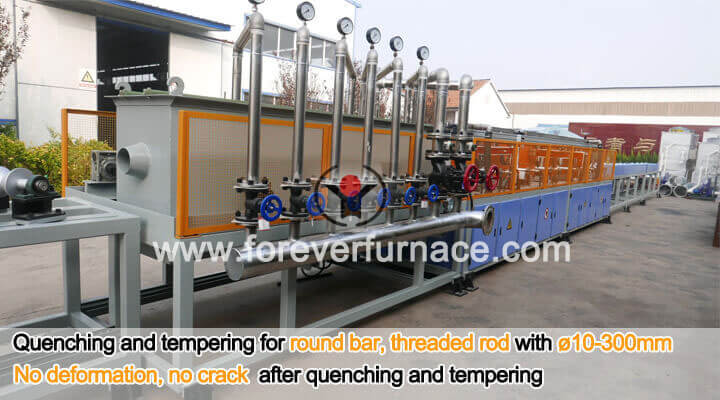Stainless steel rods can not be quenched? You need the right way to harden stainless steel bars.
The working principle of the stainless steel bar quenching is that the stainless steel bar will produce strong alternating electromagnetic field when it goes through the coils of induction heating furnace and the alternating current is induced in the stainless steel bar workpiece, and the current mainly concentrates in the stainless steel bar workpiece, so the internal temperature will be higher in induction heating.
After the bars are heated to the required heating temperature and the material structure transform from ferrite to the austenitizing, the water spray ring will spray cooling water to the steel bars to make austenitizing become martensite and reach the heat treatment that we need.

Performance characteristics of stainless steel bar quenching:
According to electromagnetic induction, fluid science, intelligent control and heat treatment, etc., we create a reasonable layout of components, easy maintenance; with function of perfect over-voltage, over-current, under-voltage, water shortage, phase, pressure limit, current limit protection system, thus ensuring the stainless steel bar quenching reliability and working stability; Central control circuit board, optimized by computer design, unit circuit optimization combination, stable device performance, reliable quality, strong anti-interference.The stainless steel heating furnace has setting of one key starting, that means they system can finish to load, heat, convey, quenching, cooling and collection with one key start.
The purpose of quenching stainless steel rods is to transform supercooled austenite into martensite or bainite, and to obtain martensite or bainite structure by quenching at the most reasonable temperature, so as to greatly improve the strength, hardness, wear resistance, fatigue strength and toughness of stainless steel rods. It can also improve the material properties or chemical properties of some special steels, such as improving the corrosion resistance of stainless steel, increasing the permanent magnetism of magnets and so on. So as to meet the different metal parts and tools of different use requirements.
After quenching, the area of fine grain zone on the surface of wear-resistant steel bar is more than three times larger than that before quenching, and phase transformation occurs rapidly, forming a certain depth of hardening layer. Hardening of wear-resistant steel bar avoids nitride and residual elements precipitating on the surface, effectively controlling the occurrence of surface micro-cracks and improving the stability of physical quality.
The above-mentioned quenching process for stainless steel bars has been successfully applied to practical production for many years. The once qualified rate after quenching reaches over 98%, which greatly improves the production efficiency and product quality of stainless steel bars and wear-resistant steel bars.
Any questions about stainless steel induction heat treatment equipment, please contact with us.

Overseas manager: Tom Wang
Email:tom@foreverfurnace.com
Phone: 0086-13303078975(whatsapp, wechat,line)
Specialist of bar heat treatment furnace in China; Glad to be your business partner in induction heating field.
Post time: 09-19-2018



